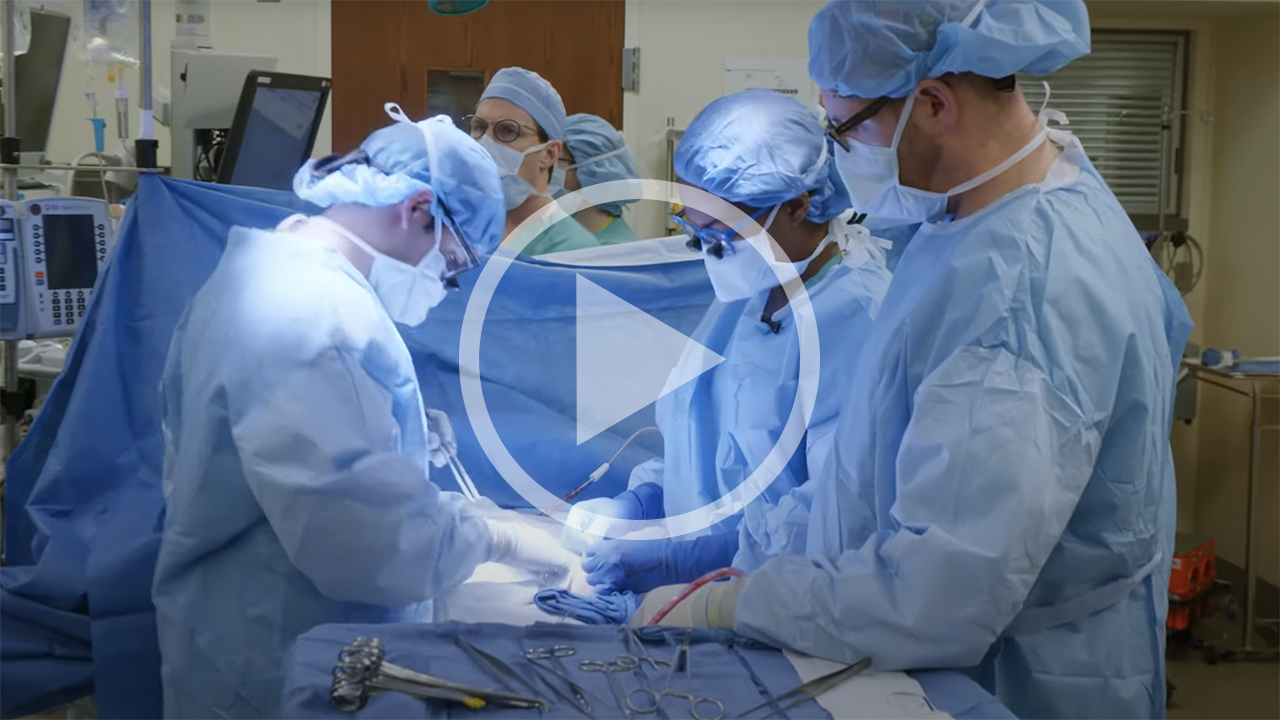Watch a kidney transplant change a life at Northwestern Medicine
Inside the OR: Kidney Transplant Surgery
Published October 2024
The human body is capable of incredible feats. But when an organ fails, life can become challenging quickly. If you have kidney disease, a kidney transplant offers a chance to reclaim your health and quality of life.
Our exclusive footage takes you inside the operating room with Dinee C. Simpson, MD, a transplant surgeon at Northwestern Medicine, to witness a kidney transplant and learn about the surgical process.
Warning: The following video shows graphic footage of a medical procedure. Viewer discretion is advised.
Video Transcript
Hi, my name is Dinee Simpson. I'm an assistant professor of surgery at Northwestern Medicine and today we're going to be going inside the OR to do a kidney transplant. The patient today is going on his second kidney transplant. Unfortunately, kidneys don't last forever and his, although lasting a long time, has run its course.
So, I'd like to invite you inside the OR today where we'll be doing our kidney transplant.
When you're putting in a sink, you have to connect a pipe that brings water into the sink and you have to connect a pipe that drains the sink. Any transplant is exactly the same so we will connect an artery that will bring blood into the kidney. A vein that will bring blood back out of the kidney. The third pipe is called the ureter and that brings the urine that the new kidney makes to the bladder. That's really all a transplant is.
So, we'll start our incision near the pubis here. I like to come up about a centimeter from there. We want to avoid his rectus muscle, which is the muscle that makes the eight-pack for those of us who are lucky enough to have one, which is not me. Then we make our incision to the side of that. There's a tube that is his old dialysis catheter. We're hopeful for is that we'll be able to remove that at the end of the surgery today. That will depend on how quickly his new kidney wakes up once we plug it in. Most of us are born with two kidneys and so when those fail, we don't have to remove those old kidneys. We leave those in place and we put the new kidney in a new location. It's really a surgeon's preference of whether or not they choose to put it on the right or on the left. So, we are going to be putting the kidney in a completely new space. It's behind the peritoneal space. The peritoneal space is the space that contains all of the intestines. What I'm going do is rotate that that way so as we pull this this way, I've created a pocket here now. I'll take this instrument to really create room so that we can work and see safely. OK, now you can see we can put two fists in there almost. So, this is our external iliac artery and this is our external iliac vein right here. Those are our pipes that we're going to be putting our kidney on.
Can we open the kidney please?
The kidney is in the cooler. It's on ice. When an organ is without blood flow and it is warm, it will start to die. So, when we take the kidney out and start to sew it in, that's when time becomes really, really important. So, this is the kidney here. This is a little bit of fat that's always around the kidney. We're going to clean it off a little bit more. So now what we're going do is we're going put the kidney in a sock because it helps free up a hand to me when we're trying to sew the kidney in, and it helps us to make sure that we sew the kidney in the correct orientation.
So, our kidney is ready to go. This becomes a well-practiced dance between the whole team to get this kidney sewn in a very quick fashion. We're going aim for less than 30 minutes.
OK, so we’re getting ready to unclamp the vein. First, we check for bleeding. It doesn't look bad. OK, you can let it go. Now we're going to unclamp the artery. That looks pretty good, too. So now what we do, we first feel to make sure we feel a good pulse. And, in the artery, we do [feel a pulse]. It’s fantastic. And now when we cut this sock off, you'll see that the kidney has changed color because it has blood flow going through it now. It's nice and pink and feels firm, which is the way we want it to be. So one of the best things to feel when you have restored blood flow to the kidney is to be able to hold it in your hand and feel a pulse. So, it feels almost like there's a little heart beating in your hand. That's the blood flow going through the kidney and that's excellent.
OK, so now what we're going do is I have the ureter here in my hand and now we're going unclamp it. Whoo! And that is what makes it all worth it. This kidney is already making urine like a champ. That's going to give us great confidence to take this gentleman's dialysis catheter out in this same operation. So, he's got a beautiful kidney that's already functioning very well.
Transplant gives patients a second chance at life. Especially with kidney disease, a patient is tied to a dialysis machine three days a week for four hours a session. Often times they're so energy depleted that they can't do anything really meaningful for the rest of the day. So, you can imagine that makes it very difficult for them to carry out life the way they want to. A transplant helps them to get back to all of those things that they love. So that's why I love transplant. Everything went great. The kidney made urine on the table so that means we take the dialysis catheter out and the patient should go home in the next two days.
Thank you for joining me inside the OR to see kidney transplantation.
Learn more about the kidney transplant process.







